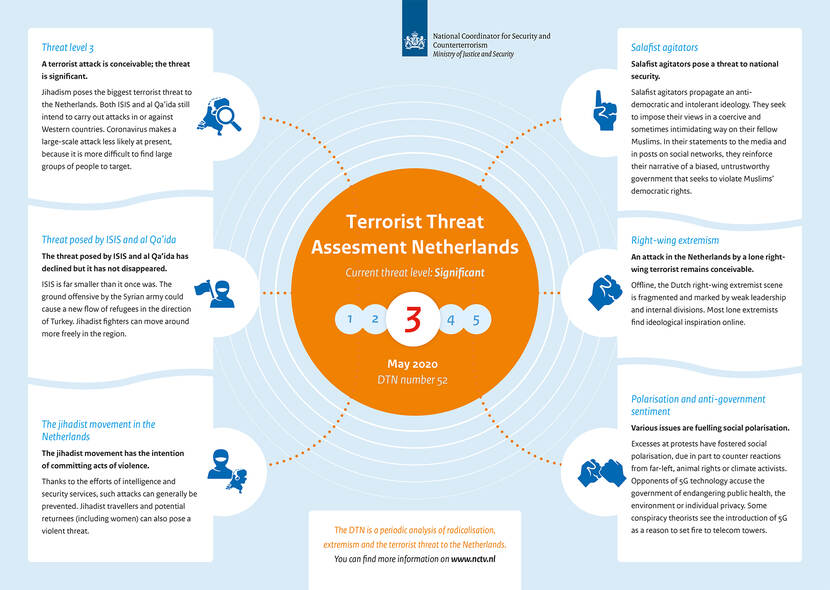Terrorist Threat Assessment: an attack in the Netherlands remains conceivable
A segment of the Dutch jihadist movement still aims to carry out a terrorist attack. In some cases this intention actually manifests itself in concrete plans. Lone actors in right-wing circles also pose a potential threat. This means that a terrorist attack in the Netherlands is still conceivable. For this reason the threat level has been maintained at 3 (on a scale of 1 to 5). However, as a result of the COVID-19 pandemic, a large-scale attack is less likely at the present time. These are some of the key conclusions of the 52nd edition of the Terrorist Threat Assessment for the Netherlands, published by the National Coordinator for Security and Counterterrorism (NCTV).
Jihadism
Jihadism still constitutes the principal terrorist threat to the Netherlands. Two categories of jihadists are a particular source of concern: imprisoned jihadists, who can exert a negative influence on one another, and returning jihadist travellers, who joined terrorist groups and gained combat experience in conflict zones abroad.
Right-wing extremism
The right-wing terrorist attack in Christchurch, New Zealand, has served as a source of inspiration for further attacks all over the world, such as in El Paso, Oslo, Halle and Hanau. An attack by a lone right-wing terrorist is also conceivable in the Netherlands. This assessment is mainly based on the possibility that a lone Dutch actor could become radicalised and then carry out an act of violence motivated by right-wing extremist ideology. Dutch right-wing extremist groups are marginal and non-violent. There are currently no leaders who exert the appeal needed to mobilise large groups of people.
Coronavirus
Jihadists see coronavirus as a form of divine intervention. Both ISIS and al Qa’ida have used the pandemic as an opportunity to pass moral judgment on the West. Now that Western troops have been withdrawn from conflict zones in the Middle East in order to help fight the pandemic in their own countries, jihadists have more room to manoeuvre. At the same time, jihadists’ freedom of movement is being impeded by the health measures taken around the world. The threat posed by coronavirus makes a large-scale attack less likely at present, because it is more difficult to find large groups of people to target.
Extremism and polarisation
As with previous editions of the Threat Assessment, various extremist and polarising trends have been identified in the period under review. For example, since early April there have been extremist incidents targeting phone masts across the Netherlands, ranging from sabotage to arson. Opponents of 5G are directing their ire at the government, which they believe is harming public health or the environment or violating privacy by introducing this new technology. The climate change debate has caused divisions within the far‑left landscape in the Netherlands. Far-left and left-wing extremist groups that were originally focused on other issues are now incorporating the issue of climate change into their discourse. The far-left movement in the Netherlands is limited in its size and level of activity, particularly when compared to its counterparts in Germany or France. For the most part the Dutch far left is more about talk than action.
